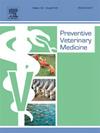Probability of Influenza A virus RNA detection at different pooling levels for commonly used sample types in swine breeding herds
IF 2.4
2区 农林科学
Q1 VETERINARY SCIENCES
引用次数: 0
Abstract
Pooling samples allows for efficient and cost-effective surveillance of endemic pathogens, enabling broader testing coverage and reducing diagnostic costs. Pooling swine samples for influenza A virus surveillance without negatively impacting sensitivity would depend on the sample type, cycle threshold (Ct value), and dilution level. Therefore, this study aimed to compare the probability of IAV reverse transcription real-time polymerase chain reaction (RT-rtPCR) detection at different pooling levels in family oral fluids, udder wipes, and nasal wipes obtained from an endemic swine breeding herd. Forty-five IAV RT-rtPCR-positive samples (15 family oral fluid, 15 udder wipes, and 15 nasal wipes) obtained from an IAV-positive herd were pooled at different levels (undiluted, 1/3, 1/5, and 1/10). For analysis, samples were categorized into three groups based on the undiluted replicates' mean Ct value: Category A - Ct < 30; Category B - Ct between 30 and 34; Category C - Ct between > 34–38. For all sample types, the probability of influenza A virus RNA detection in Ct category A and family oral fluids and udder wipes in Ct category B did not decrease when the dilution level increased to 1/10. In category C of all sample types, the probability of influenza A virus detection decreased as the dilution level increased. These findings suggest that pooling population-based samples can be an effective strategy for swine surveillance, particularly when working with samples with Ct values below 34, and future research in the field is needed to refine recommendations for field implementation.
猪种猪群常用样品类型在不同汇集水平上检测甲型流感病毒RNA的可能性
汇集样本可以有效和具有成本效益地监测地方性病原体,从而扩大检测覆盖面并降低诊断成本。收集猪样本用于甲型流感病毒监测,而不影响敏感性,将取决于样本类型、周期阈值(Ct值)和稀释水平。因此,本研究旨在比较不同池化水平家庭口腔液、乳巾和鼻巾中IAV反转录实时聚合酶链反应(rt -rt - pcr)检测的概率。从IAV阳性人群中获得的45份IAV rt - rtpcr阳性样本(15份家庭口服液,15份乳巾和15份鼻巾)按不同水平(未稀释,1/3,1/5和1/10)汇集。为了进行分析,根据未稀释重复的平均Ct值将样品分为三组:A类- Ct <; 30;B类- Ct介乎30至34;C级- Ct在>; 34-38之间。对于所有类型的样本,当稀释水平增加到1/10时,在Ct类别A和家庭口腔液和乳腺湿巾中检测到甲型流感病毒RNA的概率没有降低。在所有样品类型的C类中,甲型流感病毒检测的可能性随着稀释程度的增加而降低。这些发现表明,集中基于群体的样本可能是猪监测的有效策略,特别是当Ct值低于34的样本时,需要在未来的现场研究中完善现场实施的建议。
本文章由计算机程序翻译,如有差异,请以英文原文为准。
求助全文
约1分钟内获得全文
求助全文
来源期刊

Preventive veterinary medicine
农林科学-兽医学
CiteScore
5.60
自引率
7.70%
发文量
184
审稿时长
3 months
期刊介绍:
Preventive Veterinary Medicine is one of the leading international resources for scientific reports on animal health programs and preventive veterinary medicine. The journal follows the guidelines for standardizing and strengthening the reporting of biomedical research which are available from the CONSORT, MOOSE, PRISMA, REFLECT, STARD, and STROBE statements. The journal focuses on:
Epidemiology of health events relevant to domestic and wild animals;
Economic impacts of epidemic and endemic animal and zoonotic diseases;
Latest methods and approaches in veterinary epidemiology;
Disease and infection control or eradication measures;
The "One Health" concept and the relationships between veterinary medicine, human health, animal-production systems, and the environment;
Development of new techniques in surveillance systems and diagnosis;
Evaluation and control of diseases in animal populations.
 求助内容:
求助内容: 应助结果提醒方式:
应助结果提醒方式:


